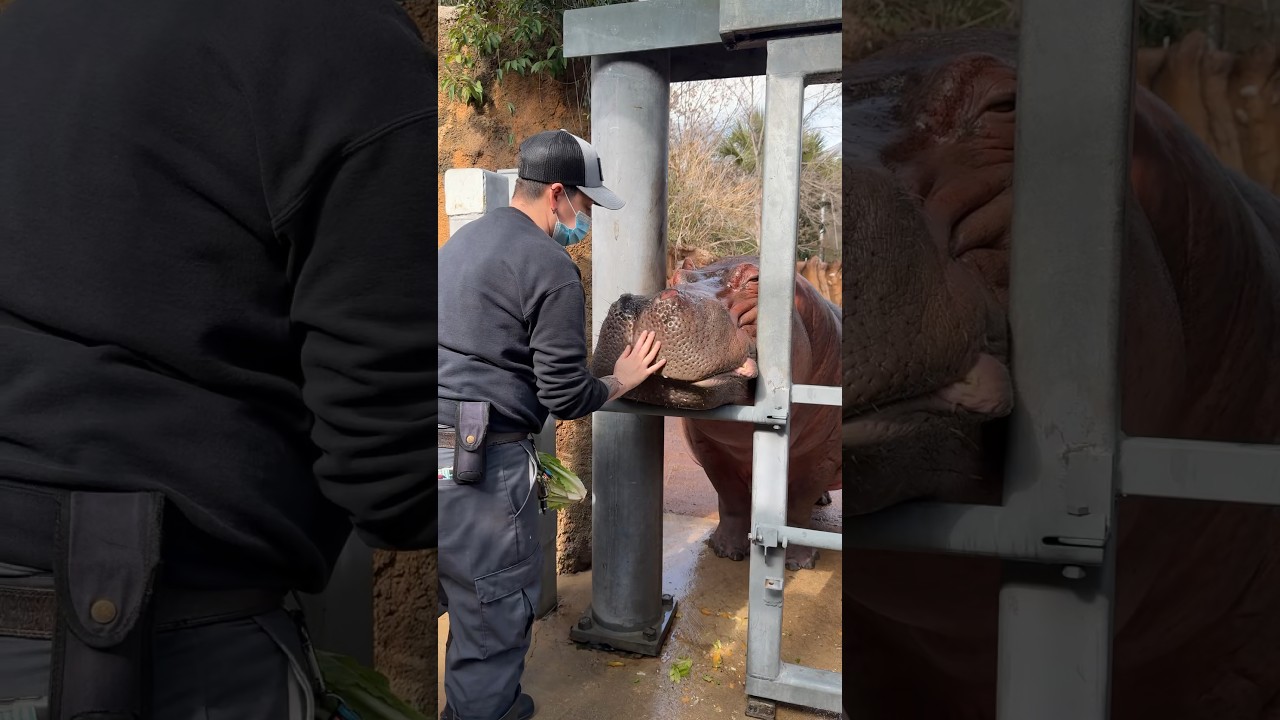– Discovering the engaging world of hippos and their unique behaviors.
– The importance of enrichment activities for animals in captivity.
– Unveiling the bond between animals and their caregivers.
The Hippopotamus is an animal that has captured the fascination of many for centuries, not just due to its immense size but also because of its complex behaviors and surprising agility in water. Among these gentle giants, one endearing character is stealing the hearts of numerous fans – let’s talk about Timothy, the charming hippo with a peculiar penchant for snout massages. This majestic creature showcases a delightful side of the Animal Kingdom, where the bonds formed between creatures and humans are as heartwarming as they are vital for the well-being of those in captivity.
To understand the significance of Timothy’s story, we should first examine hippos’ behavioral ecology and how captivity necessitates adaptations for physical and emotional health. A hippo’s life in the wild involves social structures, expansive territories, and a riverine lifestyle that defines its daily activities. However, life in a managed environment, such as a zoo or sanctuary, can’t replicate the vast African landscapes. That’s where the role of enrichment comes into play.
Enrichment is a term used in animal management to describe the provision of stimulating and challenging environments, toys, puzzles, and activities for animals. The goal is to encourage natural behaviors, prevent boredom, and improve the overall mental health of the animals. Timothy’s affection for snout massages is one delightful aspect of enrichment that has flourished due to the perceptive attentiveness of his caregivers.
Further exploring the importance of such interactions, it becomes clear that these touches go beyond just physical connections; they also build emotional rapport between animals and their human counterparts. A snout massage for Timothy feels good physically – mirroring the mud and water they would typically frolic in – and provides a comforting reassurance of safety and companionship.
When you think of a massage, you probably envision a luxurious spa treatment, but for Timothy, a snout massage is more than a simple indulgence. Hippos have a unique skin that needs constant care. In the arid wilderness, hippos spend much time submerged to protect their sensitive skin from the sun. Through this meditative interaction, Timothy gets to cool off and relax and receives necessary skin care, a practical aspect of animal husbandry often overlooked by the casual observer.
Understanding Timothy’s joy in such moments highlights the intricate balance that zookeepers and wildlife biologists strive to maintain – the balance between natural behavior encouragement and the realities of captivity. High-quality animal care practices in zoos and wildlife sanctuaries are not just about feeding and habitat cleaning. They’re about recognizing each animal as an individual with specific likes, dislikes, and needs that must be met with compassion and creativity.
What might surprise me most is that hippos’ physiology is intricately designed to support their semi-aquatic lifestyle. Their eyes, ears, and nostrils are high on their heads, allowing them to see, hear, and breathe while mostly submerged. It’s entertaining to consider that Timothy’s love for snout massages could relate to these evolutionary adaptations, where tactile sensations on their snouts are generally associated with the water they adore.
Now, let’s take a moment to appreciate the peculiar charm of hippos like Timothy. Beyond their reputation for being one of Africa’s most formidable creatures, they possess an undeniable appeal that resonates with us. We often neglect to realize that animals, much like humans, are creatures of emotion and connection. The public’s collective adoration of Timothy as he blissfully enjoys his snout massages is a testament to this shared affinity for interaction.
This tale wouldn’t be complete without acknowledging the skilled individuals dedicated to studying and caring for these creatures. Their work often requires a deep understanding of animal behavior, a robust knowledge of dietary and medical needs, and an unfailing commitment to the animals’ well-being. While interacting closely with animals like Timothy could be seen as a joyous perk of the job, it’s equally a profound responsibility to provide care that mirrors the complexity of their natural behaviors.
Timothy’s story encourages a greater appreciation for wildlife and the people who work tirelessly to enhance their lives in captive settings. It’s a compelling narrative about the mutual benefits of human-animal bonds and the importance of exceptional care for all creatures, great and small.
As we circle back to our gentle giant enjoying his massages, let’s not forget the broader lessons of conservation and empathy his story can teach us. ByUnderstanding the behaviors and needs of creatures like Timothy,can foster a deeper respect for wildlife. This can motivate us to support conservation efforts and educate others about the magnificent animals we share our planet with.
In conclusion, this hippo’s love for snout massages may seem like a simple quirk, but it’s a small part of a much larger, intricate puzzle that makes up the world of captive wildlife management. Timothy’s splash and contented sigh can serve as a reminder that these creatures, perhaps not so different from ourselves, deserve the best care, compassion, and understanding we can offer. And in providing such care, we not only enhance the lives of these animals but also enrich our human experience by celebrating the natural world’s wonders.
*****
Source Description


